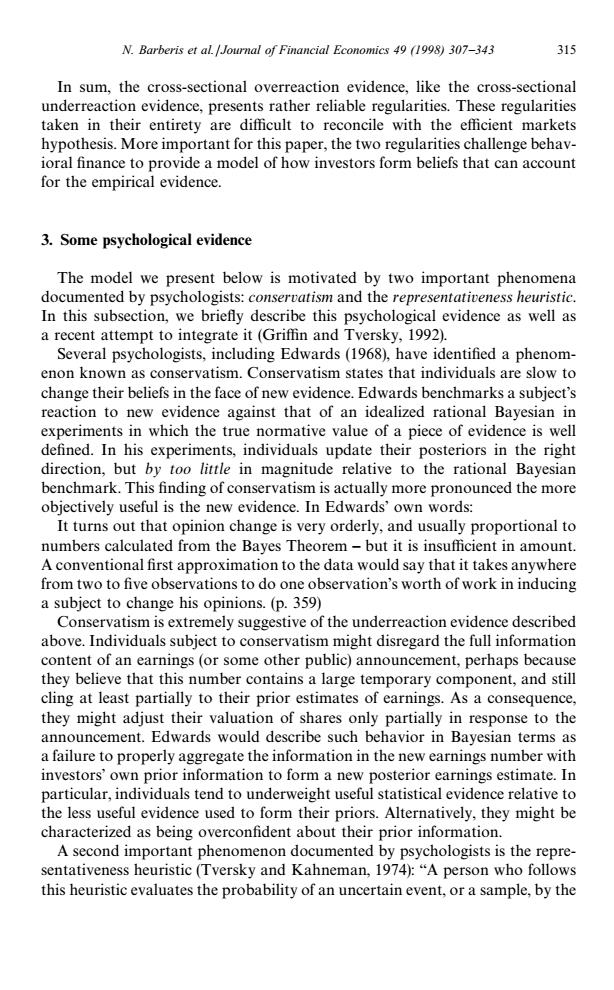正在加载图片...

N.Barberis et al./Journal of Financial Economics 49 (1998)307-343 315 In sum,the cross-sectional overreaction evidence,like the cross-sectional underreaction evidence,presents rather reliable regularities.These regularities taken in their entirety are difficult to reconcile with the efficient markets hypothesis.More important for this paper,the two regularities challenge behav- ioral finance to provide a model of how investors form beliefs that can account for the empirical evidence. 3.Some psychological evidence The model we present below is motivated by two important phenomena documented by psychologists:conservatism and the representativeness heuristic. In this subsection,we briefly describe this psychological evidence as well as a recent attempt to integrate it(Griffin and Tversky,1992). Several psychologists,including Edwards(1968),have identified a phenom- enon known as conservatism.Conservatism states that individuals are slow to change their beliefs in the face of new evidence.Edwards benchmarks a subject's reaction to new evidence against that of an idealized rational Bayesian in experiments in which the true normative value of a piece of evidence is well defined.In his experiments,individuals update their posteriors in the right direction,but by too little in magnitude relative to the rational Bayesian benchmark.This finding of conservatism is actually more pronounced the more objectively useful is the new evidence.In Edwards'own words: It turns out that opinion change is very orderly,and usually proportional to numbers calculated from the Bayes Theorem-but it is insufficient in amount. A conventional first approximation to the data would say that it takes anywhere from two to five observations to do one observation's worth of work in inducing a subject to change his opinions.(p.359) Conservatism is extremely suggestive of the underreaction evidence described above.Individuals subject to conservatism might disregard the full information content of an earnings (or some other public)announcement,perhaps because they believe that this number contains a large temporary component,and still cling at least partially to their prior estimates of earnings.As a consequence, they might adjust their valuation of shares only partially in response to the announcement.Edwards would describe such behavior in Bayesian terms as a failure to properly aggregate the information in the new earnings number with investors'own prior information to form a new posterior earnings estimate.In particular,individuals tend to underweight useful statistical evidence relative to the less useful evidence used to form their priors.Alternatively,they might be characterized as being overconfident about their prior information. A second important phenomenon documented by psychologists is the repre- sentativeness heuristic(Tversky and Kahneman,1974):"A person who follows this heuristic evaluates the probability of an uncertain event,or a sample,by theIn sum, the cross-sectional overreaction evidence, like the cross-sectional underreaction evidence, presents rather reliable regularities. These regularities taken in their entirety are difficult to reconcile with the efficient markets hypothesis. More important for this paper, the two regularities challenge behavioral finance to provide a model of how investors form beliefs that can account for the empirical evidence. 3. Some psychological evidence The model we present below is motivated by two important phenomena documented by psychologists: conservatism and the representativeness heuristic. In this subsection, we briefly describe this psychological evidence as well as a recent attempt to integrate it (Griffin and Tversky, 1992). Several psychologists, including Edwards (1968), have identified a phenomenon known as conservatism. Conservatism states that individuals are slow to change their beliefs in the face of new evidence. Edwards benchmarks a subject’s reaction to new evidence against that of an idealized rational Bayesian in experiments in which the true normative value of a piece of evidence is well defined. In his experiments, individuals update their posteriors in the right direction, but by too little in magnitude relative to the rational Bayesian benchmark. This finding of conservatism is actually more pronounced the more objectively useful is the new evidence. In Edwards’ own words: It turns out that opinion change is very orderly, and usually proportional to numbers calculated from the Bayes Theorem — but it is insufficient in amount. A conventional first approximation to the data would say that it takes anywhere from two to five observations to do one observation’s worth of work in inducing a subject to change his opinions. (p. 359) Conservatism is extremely suggestive of the underreaction evidence described above. Individuals subject to conservatism might disregard the full information content of an earnings (or some other public) announcement, perhaps because they believe that this number contains a large temporary component, and still cling at least partially to their prior estimates of earnings. As a consequence, they might adjust their valuation of shares only partially in response to the announcement. Edwards would describe such behavior in Bayesian terms as a failure to properly aggregate the information in the new earnings number with investors’ own prior information to form a new posterior earnings estimate. In particular, individuals tend to underweight useful statistical evidence relative to the less useful evidence used to form their priors. Alternatively, they might be characterized as being overconfident about their prior information. A second important phenomenon documented by psychologists is the representativeness heuristic (Tversky and Kahneman, 1974): “A person who follows this heuristic evaluates the probability of an uncertain event, or a sample, by the N. Barberis et al./Journal of Financial Economics 49 (1998) 307—343 315